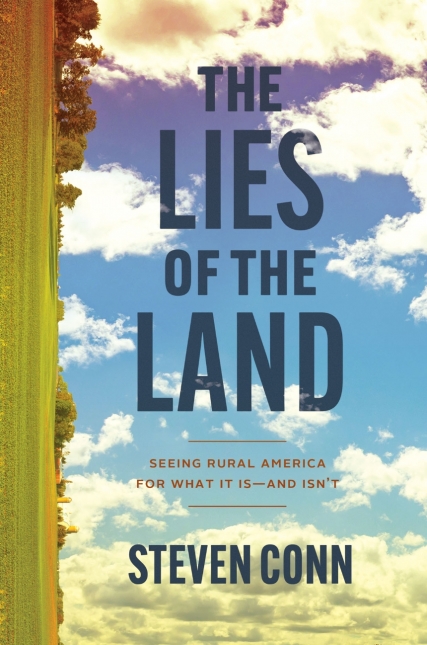The Lies of the Land: Seeing Rural America for What It Is ― and Isn’t
- By Steven Conn
- University of Chicago Press
- 320 pp.
- Reviewed by Stephen Case
- December 4, 2023
Exploding the myths surrounding sanctified, small-town flyover country.

Picturesque, pleasurable, and problem free: That’s serene, rural America, populated by “Jeffersonian yeomen” with “integrity…not…found among city dwellers.” Its residents are a “central source of civic virtue” living “in close communion with…nature.”
Right?
Not quite, contends Steven Conn in The Lies of the Land, an engaging, lively, comprehensive, and provocative study of “the Big Empty,” the area between the Appalachians and the Sierras. Despite its bucolic look, “four powerful forces of American modernity” permeate the Big Empty: militarization, industrialization, corporatization, and suburbanization. The so-called “lies of the land” are the easy-to-miss, pervasive effects of these forces — effects that show the existence of an idyllic, real-America America has always been a myth.
Take Killeen, Texas, located midway between Dallas and Austin, which “was home to a mere 1,300” people in 1941, when the government exiled 1,200 families from their own farms, seized 160,000 acres, and built what is today the 200,000-acre Fort Cavazos (formerly Fort Hood). After 1948, writes Conn, the area “would never be the same.” Around that time, many Black soldiers who’d brought home white German war brides from WWII were stationed at Fort Hood. Bedeviled, the locals called a special session of the state legislature, during which bills were introduced that sought to exclude mixed-race couples from living there because, said one scandalized white Texan, “our sense of decency is shocked.” Rural no more — and sublime perhaps never — the area today is the “Killeen-Temple Metropolitan Statistical Area.”
Agribusiness is huge in the Big Empty. Consider Gainesville, Georgia, “the poultry capital of the world,” where, 70 miles outside Atlanta, processing plants “turn out a staggering thirty million pounds of chicken every day,” and where, in 2021, a liquid-nitrogen pipe ruptured, killing six factory workers. And Stuttgart, Arkansas, 80 miles from Little Rock, which calls itself “the rice capital of the world.” Its two rice-millers are the nation’s largest recipients of federal agricultural subsidies. “Between them,” Conn reports, they’ve “brought nearly $900 million in subsidies to Stuttgart, nearly $100,000 for each resident of the town” (population: not “quite nine thousand”). Dreamy visions of these areas being filled with scrappy God-fearin’, bootstraps-pullin’ small farms are largely fictional.
This reviewer’s favorite part of the book looks at Indiana native Earl Butz, President Richard M. Nixon’s secretary of agriculture and architect of the 1973 Farm Bill. Butz’s aims were to keep food prices low by incentivizing farmers to plant fencerow to fencerow; to placate farmers by paying subsidies for overproduction; and to export that surplus overseas. Like Nixon’s, Butz’s star eventually fell: He was forced to resign in 1976, was derided for telling “one racist joke too many,” and, in 1981, did time in federal prison for tax evasion.
Said William Faulkner in 1956, summing up reality then and now, rural economies are “no longer agricultural, [they are] the federal government.” This, of course, illuminates the hypocrisy of some Southern politicians, who have “howled at having federal laws…about racial discrimination ‘imposed’ on them,” writes Conn, even though many of their constituents depend heavily on federal programs for jobs, retirement income, health insurance, and post-natural-disaster handouts.
Drive two miles outside of Anna, Ohio (pop. 1,500), and “you’ll see…Honda’s largest engine plant anywhere in the world.” Why Anna? Conn reviews multiple possible reasons but dwells on two: Was locating the facility in the tiny town a way to avoid unionization, or was it “a racial valence”? All of “Honda’s shops in the United States remain union free to this day,” he writes, and then quotes a local Black man who calls the Anna area “one of the most racist cities [sic] in…Ohio,” populated “by a lot of Appalachian people from Kentucky and West Virginia” who brought with them “their small minded belief systems.”
Contrary to the popular notion (and right-wing talking point) that the East and West coasts control America, voters in the Big Empty punch far above their weight in the U.S. Senate, a situation omitted in Conn’s analysis. The 26 least-populous Big Empty states have a combined population of around 87 million — a tad more than one-quarter of the U.S. — yet elect 52 senators. Hence, when acting in concert (which they don’t always do), Big Empty voters control the Senate. Their senators can (with approval from the House of Representatives and the president) impose any federal-policy initiative they like and (regardless of what the president and House want) stop any they don’t.
“[T]he most populous county in the United States, with 9,861,224 residents estimated in 2022,” reports Conn, is California’s Los Angeles County. The combined population of the eight least-populous Big Empty states is lower than L.A. County’s, yet those states elect 16 senators, while L.A. County elects none on its own. The idea that Hollywood and its environs steer the political direction of the nation while small, pure, innocent flyover country sits by, powerless? Another lie of the land.
Stephen Case is a member of the Independent’s board of directors and serves as its treasurer.

